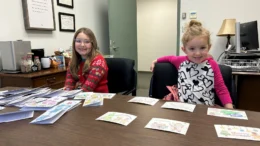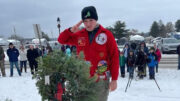One of the most thrilling days for gardeners is when the seeds get started indoors. It’s a great way to grow things that the neighbors can’t. As good as local nurseries are, they can’t carry everything. There are some things that can only be grown from seed. It’s also a money saver, as a packet of seeds is cheap and will produce a lot of seedlings.
The key is to start off with the right kind of growing medium. Use a planting mix or seed-starting mix from your favorite nursery. Don’t use garden soil or potting soil; it’s too heavy.
Moisten the mix before putting it into the container. I use plastic six-packs from last year’s flowers, but anything with drainage will do. The mix should be wet enough to stick together when squeezed, but should not drip.
Lay the seed on the mix and cover it with a thin layer of more moist mix. Press down to assure good contact between the mix and the seed. Cover the container with clear plastic and place it in a warm, bright location. I use old dry cleaner bags as they fit perfectly around a flat. When it comes to lighting you might be able to get away with a bright south-facing window, but you’re better off growing under fluorescent shop lights or some other artificial light. Hang the fluorescents from chains just inches above the plants. As soon as the seeds germinate, remove the plastic. Keep moving the lights up as the plants get taller. If they start to look a little leggy, surround the operation with aluminum foil, because it will reflect the existing light and make the plants happy.
Start fertilizing at half strength a couple of weeks after sprouting, then continue about once a week. When temperatures warm up, get the transplants outside to acclimate them to the weather, at first only for an hour and eventually overnight. It’s called hardening off, and the process takes about a week. Tender plants like tomatoes and peppers can go out into the garden around the third week of May. I usually wait until Memorial Day when the soil has really warmed up. Cool-weather seedlings like kale, lettuce, spinach, beets and other greens can go out in the garden as soon as the soil can be worked. That means when it’s dried out enough, usually in early April. Take a shovel and turn the soil over — if it sticks to the shovel, it’s still too wet to plant.
I’m often asked about the viability of seeds from previous seasons. Even though my basement is filled with mason jars stuffed with seeds, I still have ordered lots of seeds for the upcoming season. In my case I’ve got old seeds that go back 20 years. Sometimes it’s a variety I fell in love with years ago which isn’t available any longer or something I’ve forgotten about.
When I go through the jars, deciding what I want to plant, I will test the older ones to be sure they will still sprout.
It’s important the seeds are stored properly. Most importantly they must stay dry. All my mason jars have silica gel in the bottom to absorb any moisture. I bought the gel at a craft store. It’s used for drying flowers.
The first step in testing seeds is to pull out about 10 and put them in a moist paper towel. The towel is then put into a Ziploc bag and stored somewhere warm like the top of the fridge.
In a week or so, open the bag and if more than 50 percent sprouted, the seeds are good to go. If not, they go into the compost pile.
Sometimes when I don’t have enough seeds left of a variety, I’ll have to just plant one or two and hope for the best.
Seed starting is one of the wonderful parts of gardening. The smell of little tomato seedlings when brushed lightly with your hand will remind you of the summer garden.
Doug Oster is editor of Everybody Gardens, a website operated by 535Media, LLC. Reach him at (412) 965-3278 or doster@535mediallc.com. See other stories, videos, blogs, tips and more at EverybodyGardens.com.






























